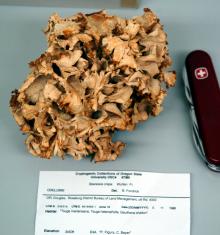Cause Sparassis crispa (formerly Sparassis radicata) , a fungus reported to be common in Washington on Engelmann spruce. Can also occur on Douglas-fir, ponderosa pine, white fir, and southwestern white pine. Both heartwood and sapwood are decayed in the roots but only heartwood in the lower trunk. It is not known how the fungus gains entry into the roots but it is not via fire scars or wounds. Tree-to-tree spread appears to be via root grafts or root-to-root contact.
Symptoms The fungus develops yellowish-white mycelial fans under the bark of the roots of old trees. The wood initially becomes reddish, finally turning yellowish brown. In the advanced stage, elongated pits filled with white mycelium are present in the decayed roots. Diseased roots are covered with resin. The fruiting bodies are found on the ground near infected roots. The base of the fruiting structure is a perennial stalk, which is connected to a decayed root. The annual growths, which consist of numerous, thin, leaf-like branches, are produced in a cluster measuring up to a foot in diameter. They are white to cream in color and arise each year from the perennial stalk (sometimes called the cauliflower fungus).
Cultural control
- Remove infected trees when thinning stands.
References Martin, K.J., and Gilbertson, R.L. 1978. Decay of Douglas-fir by Sparassis radicata in Arizona. Phytopathology 68:149-154.
Shaw, C.G., and Harris, M.R. 1960. Important diseases and decays of trees native to Washington. Ag Extension Service, WSU. Extension Bulletin 540.



